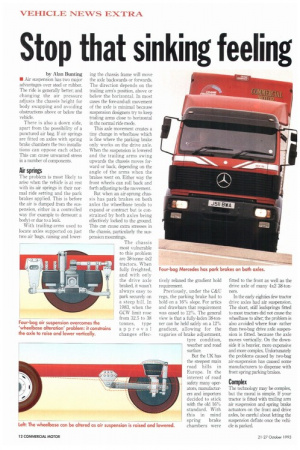Stop that sinking feeling
Page 14

If you've noticed an error in this article please click here to report it so we can fix it.
by Alan Bunting • Air suspension has two major advantages over steel or rubber. The ride is generally better: and changing the air pressure adjusts the chassis height for body swapping and avoiding obstructions above or below the vehicle.
There is also a down side, apart from the possibility of a punctured air bag. If air springs are fitted on axles with spring brake chambers the two installations can oppose each other. This can cause unwanted stress in a number of components.
The problem is most likely to arise when the vehicle is at rest with its air springs in their normal ride setting and the park brakes applied. This is before the air is dumped from the suspension, either in a controlled way (for example to demount a body) or due to a leak.
With trailing-arms used to locate axles supported on just two air bags, raising and lower
ing the chassis frame will move the axle backwards or forwards. The direction depends on the trailing arm's position, above or below the horizontal. In most cases the fore-and-aft movement of the axle is minimal because suspension designers try to keep trailing arms close to horizontal in the normal ride mode.
This axle movement creates a tiny change in wheelbase which is fine where the parking brake only works on the drive axle. When the suspension is lowered and the trailing arms swing upwards the chassis moves forward or back, depending on the angle of the arms when the brakes went on. Either way the front wheels can roll back and forth adjusting to the movement.
But when an air-sprung chassis has park brakes on both axles the wheelbase tends to expand or contract but is constrained by both axles being effectively locked to the ground. This can cause extra stresses in the chassis, particularly the suspension mountings.
The chassis most vulnerable to this problem are 38-tonne 4x2 tractors. When fully freighted, and with only the drive axle braked, it wasn't always easy to park securely on a steep hill. In 1983, when the GCW limit rose from 32.5 to 38 tonnes, type approval changes effec
tively relaxed the gradient hold requirement.
Previously, under the C&U regs, the parking brake had to hold on a 16% slope. For attics and drawbars that requirement was eased to 12%. The general view is that a fully-laden 38-tonner can be held safely on a 12% gradient, allowing for the vagaries of brake adjustment, tyre condition, weather and road surface.
But the UK has the steepest main road hills in Europe. In the interest of road safety many operators, manufacturers and importers decided to stick with the old 16% standard. With this in mind spring brake chambers were fitted to the front as well as the drive axle of many 4x2 38-tonners.
In the early eighties few tractor drive axles had air suspension. The short, stiff leafsprings fitted to most tractors did not cause the wheelbase to alter, the problem is also avoided where fourrather than two-bag drive axle suspension is fitted, because the axle moves vertically. On the downside it is heavier, more expensive and more complex. Unfortunately the problems caused by two-bag air-suspension has caused some manufacturers to dispense with front spring parking brakes.
The technology may be complex, but the moral is simple. If your tractor is fitted with trailing arm air suspension and spring brake actuators on the front and drive axles, be careful about letting the suspension deflate once the vehicle is parked.
































































































